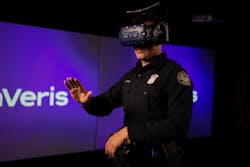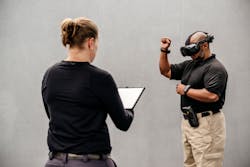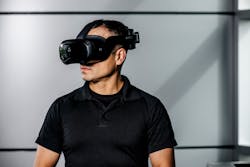Virtual Training, Real Results: How Virtual Reality Hones Skills
Live events can require hiring actors; It means securing a location that’s both ideal for training and available. Then factor in the time needed for officers to participate, and live events can become a strenuous undertaking before a single drill has been run.
Law enforcement simulators are an alternative. They use multiple projection screens to run through various interactive scenarios that an officer must navigate. While effective, these simulators require a large commitment of space and funding.
“Obviously, it’s a resource issue. It’s a logistics issue of actually getting people over to the academy, pulling people off the field and kind of figuring out when do they actually have five days of pure classroom time,” Chris Chin, vice president of immersive technology for Axon, tells OFFICER Magazine. “It’s the actual modality of learning in a classroom setting or learning with traditional ways where it’s very much one direction. One direction, and you’re kind of learning by PowerPoint. So death by PowerPoint or by binders, if you will.”That’s why the prospect of virtual reality training is such an attractive and intriguing idea to many law enforcement agencies. VR systems, like those developed by InVeris Training Solutions and Axon, allow officers to train in an immersive, three-dimensional environment with the aid of a headset and a tablet or a laptop.
“VR scenarios are far more adaptive and dynamic—anything can happen, at any time, resulting in more situations, more environments. Instructors can create or customize characters that law enforcement officers encounter on a regular basis,” says Robert Beliles, chief product officer for InVeris.
“Virtual reality makes it so much more real, so trainees get more out of it, and they remember the experience while on the street,” adds Curry Newton, director or law enforcement virtual sales for InVeris. “Much more than they would based on the older technologies.”
InVeris’ VR training system employs head-mounted displays that officers wear to enter a 3-D world and run through scenarios centered around marksmanship, de-escalation and judgment. Inside these environments, officers are virtually equipped with essential gear, such as a service weapon, TASER and pepper spray.
“The trainee can interact with the environment to a far greater degree than what a 2-D projection screen can offer,” says Beliles. “We’re able to do things with computer-generated images and graphics that can’t be easily done with branched video (in projection screen simulators).”
Although virtual reality has rapidly been securing a significant cultural foothold, it’s still viewed in certain corners as technology used to play video games. In a law enforcement setting, some officers—especially older ones—can be skeptical about learning a new way to train, especially a program centered around a device used by thousands of teens daily.
“Everybody comes in and generally says, ‘Hey, my kids got one of these VR thingies at home,’ and I’m like, ‘That’s awesome. You ought to try it,’ and they put our system on,” says Newton. “When they take it off, they say, ‘This is nothing like what my kids got at home.’ ”
Sgt. Joshua Calle of the Phoenix Police Department says some officers needed a little extra time to adapt to the digital experience, with a couple feeling “seasick” using the technology. But the small hiccup “worked itself out,” and the training has “flowed seamlessly,” he adds.
Phoenix police partnered with Scottsdale-based Axon in 2020 and became one of the first departments to conduct empathy training with a virtual reality system. So far, Calle says officers have liked what they’ve seen with the digital technology.“I’ve received a lot of more positive feedback than negative… In our training, we got more positive feedback as we went along,” he says.
Creating a seamless VR training experience means building vivid interactive worlds that a participant can maneuver through intuitively. Newton takes pride in the details InVeris has included in its digital simulations.
“When you walk into the VR bar scenes and you look over at the bar, you see lit cigarettes and the smoke trail coming off of it,” he says. “You got multiple sports games on the bar TV. The pool balls are actually moving when struck. There is so much cool stuff inside of these VR scenarios and VR environments. It is so immersive. It’s something you really need to experience.”
Ultimately, quality virtual reality experiences for Newton are when officers are so engaged in a simulation that they forget they’re wearing a headset.
“I won’t tell you where, but I had an older chief put on the headset, get into an altercation with a suspect in a scenario and the character moved toward him and the chief backed out of the way and ran into a wall (in real life),” he says. “He was completely in to it. I have had officers do vehicle searches in a VR scenario and try and get into the car and fall down. I had a prospective customer take off after a suspect and ran flat into all of our equipment.”
Swapping Roles
Simulating real-world emergency calls from a law enforcement perspective during an incident doesn’t have to be the only focus of VR training. For its virtual reality system, Axon has incorporated a communication management component for its empathy training. This facet allows participants to experience a call as both officer and citizen in scenarios centered around mental health and trauma prevention In the citizen perspective, says Robert Murphy, Axon’s director of virtuality. And in the citizen perspective, the system can simulate certain physical and mental experiences connected to specific disabilities and disorders.
“In one perspective, you are embodying a community member who is experiencing a situation as police arrive on the scene,” says Murphy. “For example, in the sense of our schizophrenia module, you’re hearing the voices in your head.
You’re getting context to why this person is acting the way they are. As law enforcement comes on the scene, (they encounter someone with) autism. You’re getting the sensation of how the stimulus from the lights and the sirens of the police car actually can escalate the situation for that person that is autistic.”
In the Axon system, the communication management training component primes the officer for an even more immersive VR experience. Like the InVeris system, Axon puts an emphasis on de-escalation tactics to create better outcomes—to “make the bullet obsolete,” as Chin puts it.
“Now, our scenario around domestic violence… where we start with the domestic violence web based training, we have the domestic violence communication training module, and then we have the domestic violence training module, where there’s a variety of scenarios that you’d go through, ranging from just a loud argument to an assault occurring, so officers have to practice their critical thinking skills to get to the successful outcome,” says Murphy about its new domestic call simulation, which debuted in late May.Trainer’s perspective
Virtual reality systems aren’t just a potential boon for trainees. They also are capable of enhancing the trainer’s job. With the InVeris system, training officers can manipulate “characters” and scenarios in response to a trainee’s actions. The system also collects data, such as tracking eye movements, information that can be used to hone and refine an officer’s skills.
“Most officers are going to tell you, ‘Yeah I looked,’ and you go, ‘Well that’s not what your eyes said, you know?’” says Curry about evaluating officers in VR training. “And you have them look, and you show them you did not look right. Or you didn’t see this, or I know you didn’t see it because you weren’t looking over there.
“You have so many, so many instructional tools at your hand, at this point, that you can walk people through stuff and make them remember, ‘Hey you got to look around, you got to see what’s happening for your safety and everybody else.’”
With their limited gear and space requirements, VR systems give trainers the ability to interact with officers during exercises from practically anywhere. That means trainer and trainee don’t have to be tied down to a specific location.
“This can also be used remotely,” says Chin. “So the trainer and training can be in different locations, and you can do it any time. You could do it before roll call or after roll call, when you have a 10 to 15 minute downtime or break where you can do micro trainings. It just gives you that full flexibility.”
The Phoenix Police Department has experimented with that kind of impromptu, “roll call” training early on, but it hasn’t been regularly used as an option, says Calle. It’s a feature, however, that he hopes the department will employ more often in the future.
“It’s portable, it’s easy to use, it’s easy to set up,” says Curry. “It’s easy to pack up and boom, set it up, run you through some scenarios and send it back out.”
On the horizon
Even though virtual reality has made sweeping technological strides in the past decade, InVeris and Axon officials are optimistic that the tool will keep evolving. Both companies see haptic feedback—the ability to physically feel in the real world experiences in the virtual world—as the next big step on the horizon. In fact, Chin foresees a time when an officer could actually “touch,” “grab” and “handcuff” a virtual suspect.
“We’ve gotten some requests about like, ‘Hey, what if you actually physically engage with somebody?’” he says. “So that haptic feedback, I’m actually trying to have someone assault you. And how do you defend yourself against that if it actually comes to more melee encounters? That’s a current limitation… but that’s something down the line. We would look to try to see how we would, as a technology evolves, how we could incorporate that into some of our own training here.”
The future promise of virtual reality, however, hinges on its effectiveness in training generations of law enforcement officers. And in a relatively brief span of time, officers using the InVeris have already reaped positive results, says Beliles.
“We’ve seen substantial improvement in terms of what (officers’) performance is,” he adds. “And again, it’s not really just muscle memory. It’s that mental muscle memory, right? That if you’ve been through this scenario before, the more realistic that you can make it then there’s a higher level of retention by the trainee as a result of feeling and being right there. Trainees can repeat scenarios as many times as they want, or as the instructor would like them to. To really drive home the point and play out things differently, they can say, ‘Well, what if I said it this way? What if I did this instead?’ So you can go at it from different angles and see what the outcome is each time.
“Ultimately, you know could what happen, you’re more prepared, once you’re on the street and encounter those situations.”





